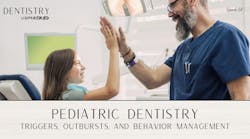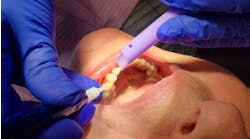AAP releases new pediatric opioid guidelines: What dentists should know
The American Academy of Pediatrics (AAP) recently published a new set of clinical practical guidelines on opioid prescriptions for children with acute pain, and they want dentists to take note. The AAP includes dentists in its definition "pediatricians and other pediatric health care providers," as they provide care for children and adolescents with acute pain.
But is there ever a reason to prescribe opioids for a pediatric patient?
In 2023, the American Dental Association (ADA) released its own guideline for the management of acute dental pain in children. It does not give guidance on prescribing opioids medications, other than to note that the use of tramadol and codiene for children has been restricted by the FDA since 2017. Instead, the guideline says the use of acetominaphin and NSAIDS is sufficient to manage post-extraction pain, and notes that opioids carry considerable risks, even when prescribed appropriately.2
However, the AAP's guideline takes a different approach: "This CPG makes an evidence-based recommendation to provide opioids when it is appropriate for treating acutely worsened pain in children." While acknowledging the contribution of medical providers to the opioid epidemic, the guideline also argues that withholding of opioids from patients has left some pain untreated, and "clinicians and health systems have contributed to inequities by race, ethnicity, and other factors."1
The AAP guidelines
According to the AAP, clinicians should start with the lowest possible dose based on the child's age and weight, use an immediate-release formula, and provide no more than a 5-day supply. The AAP guidelines recommend nonopioid approaches whenever possible:
"Although opioids are an important tool for acute pain relief, not all acute pain requires opioids. Recent studies and expert consensus suggest that even conditions that have traditionally been thought to require opioids—such as tonsillectomy, third molar surgery, and acute fractures—may have equally effective analgesia with fewer side effects using acetaminophen and nonsteroidal anti-inflammatory drugs (NSAIDs) alone."1
If opioids are indicated for a patient's pain, providers should still consider combining these with acetaminophen or nonsteroidal anti-inflammatory drugs, as this can help reduce the side effects associated with high doses of these medications.1
Restricting the use of codeine or tramadol is important for children under the age of 12, teens aged 12-18 with obesity, obstructive sleep apnea, or severe lung disease, and anyone under 18 suffering from postsurgical pain after a tonsillectomy or adenoidectomy.1
Nalaxone
As an extra precaution, the guidelines recommend providing naloxone with each prescription to prevent a possible overdose. Clinicians should help a patient's caregiver/caregivers recognize the signs of overdose as well as how to safely store and dispose of opioids.1
Note that nalaxone is increasingly available over the counter, however. As of September 2023, Narcan was available without a prescription around the United States.3
Prescribing with safety in mind
It's also important to mention that opioids should not be the only strategy used for pain management. Over the years, prescribing opioids to children and adolescents became less common as the health-care industry's role in the opioid epidemic became understood.
However, as the guideline mentions, a decline in opioid distribution has left many children without an adequate way to manage their acute pain. This is especially true for non-White patients and those in underserved socioeconomic areas.1
According to Dr. Rita Agarwal, a pediatric anesthesiologist at Stanford University in Stanford, California, the AAP's new guidelines can mend some of these disparities by bringing a much-needed objectivity to the prescription process. The AAP's main goal is to mitigate pediatric pain while reducing the risk for overdose, addiction, and drug abuse.1
Opioids in pediatric dentistry
Generally, opioids and other medications may be prescribed to relieve pain caused by tooth extraction, abcess, or other dental surgery. Hydrocodone, oxycodone, and acetaminophen with codeine are the most commonly prescribed opioids for dental pain management for adult patients. NSAIDs are increasingly recommended because they are safe and effective for helping patients manage their acute dental pain; unlike opioids, they have no abuse potential.4,5
Like the ADA, the AAP also recommends NSAIDs as first-line medications for pain management for children. They also recommended prescribing opioids only if nonopioid treatment is ineffective; preemptive analgesia, profound anesthesia, and non-pharmacologic techniques should be a routine part of pain management. However, if opioids are necessary, children should take them for no longer than three consecutive days with the lowest possible dose. Codeine should not be given to any child under the age of 12.5
Today, most pediatric opioid prescriptions in a dental setting are affiliated with oral surgery, but may also be used for orthodontic, endodontic, restorative, adjunctive, or periodontal reasons—albeit less commonly.6,7 However, due to the health risks involved, opioid prescription in children has decreased within the past decade.6,7
These new guidelines represent the difficulty dentists face in treating patients' pain. Pain is a subjective experience; a procedure that may be tolerable for one person can be excruciating for another. Untreated pain is associated with physical impairment and psychological distress and negatively impacts a child's recovery.1 While there may be no easy answer when it comes to how dentists should prioritize the different available guidelines, it's important to do what is best for each patient based on the available evidence.
References
-
Hadland S, Agarwal R, Raman S, Smith M, Bryl A, Michael J, et al. Opioid prescribing for acute pain management in children and adolescents in outpatient settings: clinical practice guideline. American Academy of Pediatrics. September 2024. https://publications.aap.org/pediatrics/article/doi/10.1542/peds.2024-068752/199482/Opioid-Prescribing-for-Acute-Pain-Management-in
-
Carrasco-Labra A, Polk DE, Urquhart O, et al. Evidence-based clinical practice guideline for the pharmacologic management of acute dental pain in children. J Am Dent Assoc. 2023;154(9):814-825.e2. doi: 10.1016/j.adaj.2023.06.014
- Gragnolati AB. Where and how to get Narcan (naloxone), the opioid overdose antidote. GoodRx. June 3, 2024. https://www.goodrx.com/narcan/where-to-get-narcan-and-naloxone-without-a-prescription
- Glassberg A, Madej B. What pharmacists want dentists to know when prescribing: New online drug resource will help. DentistryIQ. September 2024. https://www.dentistryiq.com/dentistry/pharmacology/article/55137211/what-pharmacists-want-dentists-to-know-when-prescribing-new-online-drug-resource-will-help
-
Remaly J. New guideline for managing toothache in kids. Medscape. August 2023. https://www.medscape.com/viewarticle/996048
-
Matthews DC, Brillant MGS, Jimoh KO, Singleton W, McLean-Veysey P, Sketris I. Patterns of opioid prescribing by dentists in a pediatric population: a retrospective observational study. CMAJ Open. 2019 Aug 6;7(3):E497-E503. doi: 10.9778/cmajo.20190021. Erratum in: CMAJ Open. 2019 Oct 25;7(4):E638-E639. doi: 10.9778/cmajo.20190174
-
Okunev I, Frantsve-Hawley J, Tranby E. Trends in national opioid prescribing for dental procedures among patients enrolled in Medicaid. J Am Dent Assoc. 2021 Aug;152(8):622-630.e3. doi: 10.1016/









